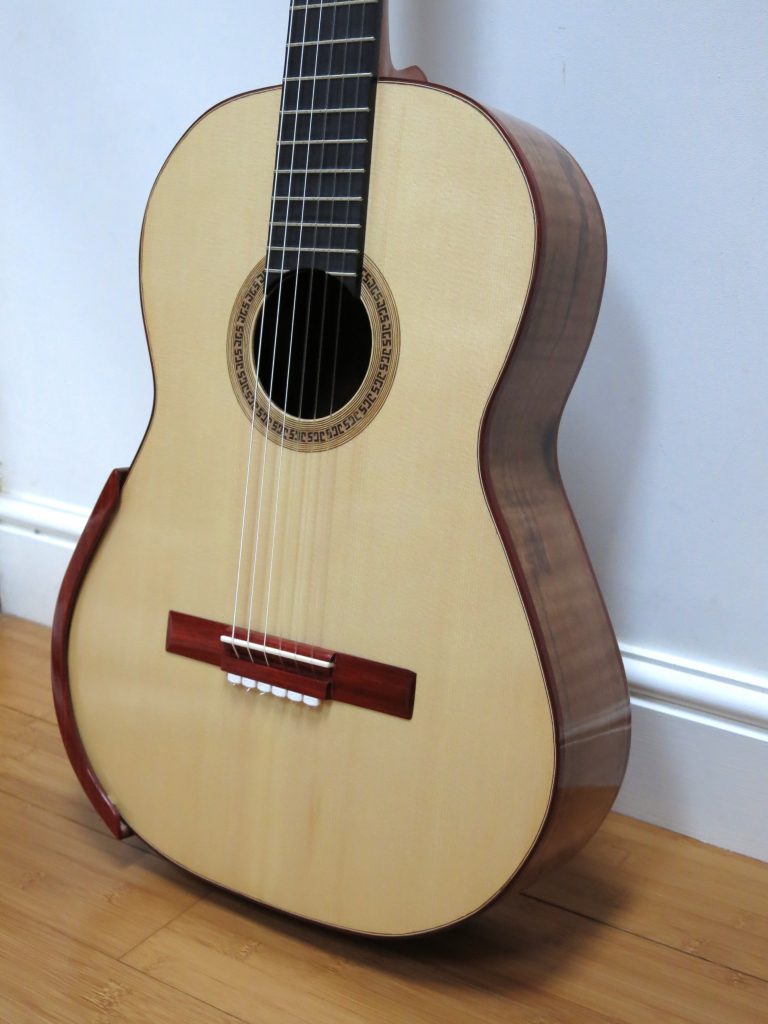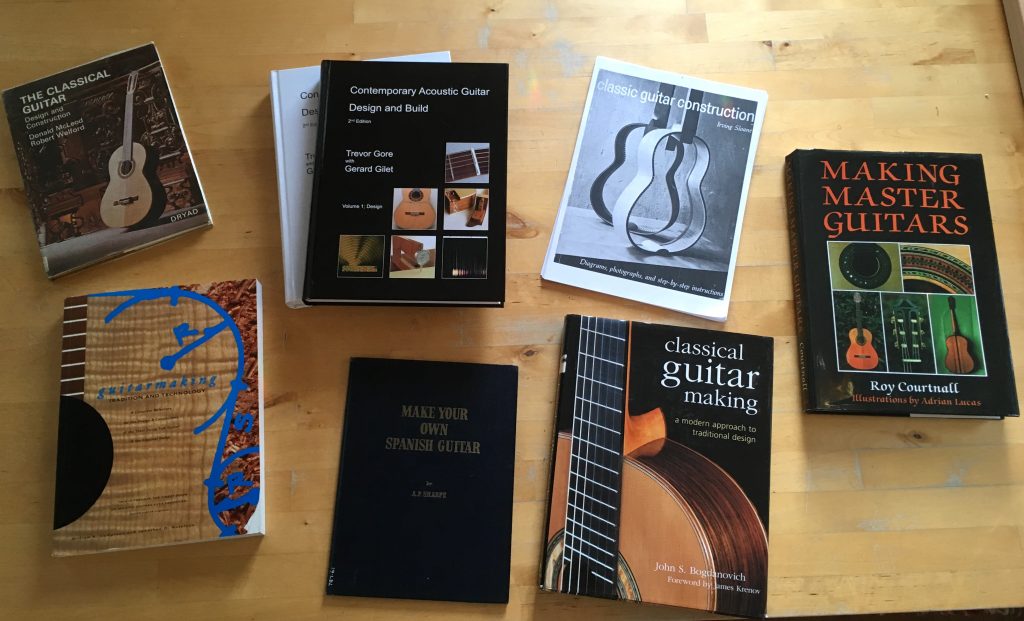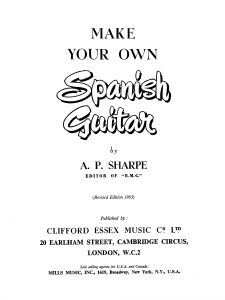
This is a selected, English-language bibliography of literature about or directly relevant to classical guitar making (lutherie). It relates to the making of the modern classical (‘Spanish’) guitar, i.e. the design of instrument going back to Antonio de Torres in the mid-19th century, not the steel-stringed (‘folk’) guitar (although I acknowledge the overlap, but want to keep it focused). There is a lot of literature aimed at or about players of the classical guitar, much of which is not included here unless it is likely to be of interest to luthiers. Finally, there is a constantly growing number of articles published in scientific journals that could also be listed here but on the whole have not been included. Books in the ‘Science’ section offer a sufficiently in-depth discussion of acoustics, and structural engineering and make reference to the peer-reviewed literature.
Suggested additions from enthusiasts, luthiers and organologists are very welcome in the comment box below. Thank you.
The craft
Bogdanovich, John S. (2007) Classical Guitar Making: A Modern Approach to Traditional Design
Courtnall, Roy (1993) Making Master Guitars
Guitarmaking: Tradition and Technology
Cuzzucoli, Giuseppe (2015) Classical Guitar Design
Doubtfire, Stanley (1983) Make Your Own Classical Guitar
Friederich, Daniel (1998) The classical guitar soundboards and their bracing
Gore, Trevor and Gilet, Gerard (2011) Contemporary Acoustic Guitar Design and Build (2 vols.)
Guild of American Luthiers (1985-2005) The Big Red Book of American Lutherie Vols. 1-7
Hofmeister Jr., Theodorus M. (1954) Torres. The Creator of the Modern Guitar, Guitar Review
Hoing, Clifford A. (1955) Making a Guitar, Woodworker
Huttig, H. E. (1965) Guitar Construction from A to Z, Guitar Review no.28
Huyn, Peter et al. (1966) A Guitar Manual
McLeod, Donald and Welford, Robert (1971) The Classical Guitar. Design and Construction
Middleton, Rik (1997) The Guitar Maker’s Workshop
Oribe, Jose (1985) The Fine Guitar
Overholtzer Arthur E. (1974) Classic Guitar Making
Ramirez III, J. (1993) Things about the guitar
Ridge, Eric V. (1956) The Birth of a Guitar, Guitar News
Romanillos, Jose L. (2013) Making a Spanish Guitar
Romanillos, Jose L. (1979) The Classical Guitar. In: Ford, Charles (Ed.) Making Musical Instruments: Strings and Keyboard. London: Faber & Faber.
Sharpe, A. P. (1957) Make Your Own Spanish Guitar
Somogyi, Erwin (2010) The Responsive Guitar (2 vols.)
Sloane, Irving (1966) Classic Guitar Construction
Wallo, Joseph F. (1965) How To Make a Classic Guitar
Williams, Jim (1998) Guitar Makers Manual
The science
Bader, Rolf (2005) Computational Mechanics of the Classical Guitar
Bucur, Voichita (2016) Handbook of Materials for String Musical Instruments
Caldersmith, Graham (1995) Designing a Guitar Family
Catgut Acoustical Society Newsletter and Journal
Falk, Robert H. (2010) The Wood Handbook
Fletcher, Neville H. and Rossing, Thomas D. (1998) The Physics of Musical Instruments
French, Richard Mark (2008) Engineering the Guitar
French, Richard Mark (2012) Technology of the Guitar
Gore, Trevor and Gilet, Gerard (2011) Contemporary Acoustic Guitar Design and Build (2 vols.)
Hurd, David C. (2004) Left-Brain Lutherie. Using Physics and Engineering Concepts for Building Guitar Family Instruments
Jahnel, Franz (1981) Manual of Guitar Technology
Jansson, Erik V. (1983) Function, Construction and Quality of the Guitar
Jansson, Erik V. (2002) Acoustics for Violin and Guitar Makers
Kasha, Michael (1971) The Scientific Development of a New Classical Guitar
Lewney, Mark (2000) The Acoustics of the Guitar
Pavlidou, Maria (1997) A Physical Model of the String-Finger Interaction on the Classical Guitar
Richardson, Stephen Jon (2001) Acoustical Parameters for the Classical Guitar
Rossing, Thomas D. (2010) The Science of String Instruments
Taylor, John (1978) Tone Production on the Classical Guitar
Walker, Gordon Peter (1991) Towards a Physical Model of the Guitar
White, Tim (1979-1982) Journal of Guitar Acoustics
The history and culture
Archee, Ray (2014) The Australian School of Lutherie: Origins and Achievements, International Journal of Humanities and Social Science
Bower, Rudi (2008) A historic-hermeneutic critique of luthiery with specific reference to selected South African guitar builders, PhD thesis.
Bower, Rudi (2009) Between Scylla and Charybdis: a South African perspective on guitar building
Bower, Rudi (2011) Experience, authority and tradition in the making and playing of classical guitars: a hermeneutic interpretation, Acta Academica
Bower, Rudi (2009) Heidegger, art, technology and luthiery, Acta Academica
Braun, Tobias, Karel Dedain, Siegfried Hogenmüller, Gerhard Oldiges and Alberto Martinez (2021) Vicente Arias
Busch, Otto. V. (2012), Man–machine–music: Resonances of craft and technology in a study of guitar building, Craft Research
Button, Stuart (1984) The Guitar in England 1800-1924
Coates, Kevin (1985) Geometry, proportion, and the art of lutherie (Original PhD thesis)
Coelho, Victor Anand (2011) The Cambridge Companion to the Guitar
Dawe, Kevin with Moira Dawe (2001) Handmade in Spain: The Culture of Guitar Making, in Andy Bennett and Kevin Dawe (eds.) Guitar Cultures.
Dudley, Kathryn Marie (2014) Guitar Makers. The Endurance of Artisanal Values in North America.
Evans, Tom and Mary (1984) Guitars: Music, History, Construction and Players from the Renaissance to Rock
Greenberg, James B. (2016) Good Vibrations, Strings Attached: The Political Ecology of the Guitar, Sociology and Anthropology
Grondona, Stefano and Waldner, Luca (2001) La Chitarra di Liuteria—Masterpieces of Guitar Making
Hanusch, Christoff (2011) Guitars by Richard Jacob
Huber, John (1994) The Development of the Modern Guitar
Kies, Thomas J. (2013) Artisans of Sound: Persisting Competitiveness of the Handcrafting Luthiers of Central Mexico, Ethnomusicology Forum
Kies, Thomas J. (2008) Aesthetic Judgements of Luthiers: A Case Study of Mexican Guitar-Makers, The Galpin Society Journal
Martin, Darryl (1998) Innovation and the Development of the Modern Six-String Guitar
Martinez, Alberto (2018) 34 Classical Guitars in Life Size
McCreadie, Sue (1982) Classical Guitar Companion
Melo, Josep (2020) José Luis Romanillos – Guitars, The Guijosa Period
Morrish, John (1997) The Classical Guitar: A Complete History
Nex, Jennifer Susan (2013) The Business of Musical-Instrument Making in Early Industrial London
Ray, John (2014) The Granada School of Guitar-Makers
Ray, John et al., (2016) A review of basic procedures for an organological examination of plucked-string instruments, Journal of Cultural Heritage
Rodriguez, Manuel (2010) The Art and Craft of Making Classical Guitars
Romanillos, Jose L. (2002) The Vihuela de Mano and The Spanish Guitar
Romanillos, Jose L. (1997) Antonio de Torres, Guitar Maker – His Life & Work
Schott, Howard (1975) Instrument Makers-1: Luthiers. Howard Schott Visits the Workshops of David Rubio and Michael Lowe
Schramm, David (2005) The Definitive Elements of the Hermann Hauser Spanish Guitar
Sharpe, A. P. (1954) The Story of the Spanish Guitar
Southwell, Gary (1983) The Panormo Guitar and its Makers
Suwa, Kazu (n.d.) Interviews with classical guitar luthiers
Turnbull, Harvey (1974) The Guitar from the Renaissance to the Present Day
Tyler, James and Paul Sparks (2002) The Guitar and its Music. From the Renaissance to the Classical Era
Urlik, Sheldon (2015) A Collection of Fine Spanish Guitars from Torres to the Present
Usher, Terence (1956) The Spanish Guitar in the Nineteenth and Twentieth Centuries
Vorreiter, Florian (n.d.) Research on historical guitars – Studying and documenting artistic details and construction (study of Torres FE18)
Wade, Graham (1980/2012) Traditions of the Classical Guitar
Wade, Graham (2001) A Concise History of the Classical Guitar
Westbrook, James (2009) Investigative Methods for the Study of Historical Guitars: A Case Study of the Work of Antonio de Torres. MA Dissertation. London Metropolitan Univesity.
Westbrook, James (2013) Louis Panormo: ‘The only Maker of Guitars in the Spanish style’
MAGAZINES
Orfeo (2013 – )
Classical Guitar (1982 – )*
American Lutherie (1985 -)
Soundboard (1974 – )*
Guitar News (1951 – )*
Guitar Review (1946 – 2009)*
Banjo Mandolin & Guitar (BMG) (1903 – 1976)*
*Primarily focused on classical guitar playing but often contain profiles of luthiers and articles on the history of lutherie.



